Fall is a season buzzing with a harvest of vegetables that love the cool season! Let’s look at the top 10 cool season vegetables you must grow in the fall season.
- Brussel Sprouts
Brussels sprouts are best grown in the fall season and produce cruciferous vegetables that resemble mini cabbage-like vegetables along the stems. Individual brussels sprouts can be harvested by cutting the sprouts off with a knife. When harvesting the entire plant, you can use heavy-duty pruners to cut the stem and harvest the sprouts from there. The plant also produces in enormous amounts so this can provide large harvests of very fresh and delicious brussels sprouts. Brussel sprouts are not only a giving plant but they taste amazing too, and come with many health benefits. They are low in calories and high in many nutrients, like fiber, vitamin K, and vitamin C. The vegetable is especially rich in magnesium and phosphorus, providing a delicious vegetable filled with antioxidants, fiber, and gut benefits. As stated before, brussel sprouts are best grown in the cool fall weather as the heat can cause them to bolt (produce flowers) or to produce hard, inedible sprouts.
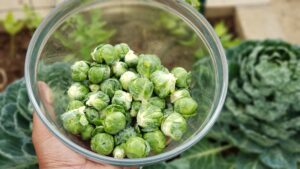
Brussel Sprouts
- Beets
Beets are extremely easy to grow and harvest from small containers as well as whiskey barrel containers. They tend to branch out and produce beetroots in the whiskey barrel container very nicely. We have also grown beets in our vertical growing system, the greenstalk planter, to save space and produce high amounts of beets. Personally, we have gotten really good results from growing them in the smaller pockets of the green stalk leaf planter and I highly recommend growing beets in a vertical system. If you’re planning to get your own green stalk planter, use coupon code “cag” to save an additional $10 off your order at GreenStalkGarden.com. If you are wanting larger beets, try growing them in raised beds or in the ground itself. Essentially, beets can be grown in a multitude of ways and are also very versatile in colors and flavors! The colors and flavors are due to anthocyanins, which have excellent health benefits. Beets are also a great source of fiber, folate and vitamin C, and can also help lower blood pressure and improve athletic performance.
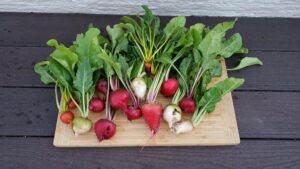
Beets
- Cabbage
Number 8 on our list is the ever mighty cabbage! This magnificent fall vegetable is easy to grow and is so delicious that you will grow this every season. Cabbage heads form very well in the cooler months and have several varieties that you can grow. We grow conical head cabbages, which are typically not sold in grocery stores, so it’s great to grow your own. Cabbages can be grown in raised beds and containers but to achieve large cabbage heads, raised beds are a great option. One thing to note about cabbages is that they have some insects that you need to deal with, such as worms and slugs. Cabbage is a fall and winter vegetable as hotter weather conditions lead to the cabbage not forming a head, being malformed and producing only flowers. Cabbage is a great vegetable to grow since it’s a low-calorie food that is rich in vitamin C and vitamin K. It also helps to reduce inflammation and contributes to digestion and good gut health.
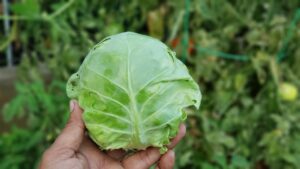
Cabbage
- Cauliflower
Next is cauliflower, one of my favorite vegetables to grow and eat. Just like its other cruciferous vegetable cousins, cauliflowers require a good dose of an all-purpose fertilizer preferably organic when starting out and later, worm tea and fish emulsion every 15 days following planting. Cauliflowers grow great in raised beds as the extra spacing helps them produce good-sized heads. However, they can very well be grown in containers, such as whiskey barrel containers or 5 gallon containers. Cauliflowers grown during the hotter months are plagued with problems such as buttoning, where the heads do not form but rather you see a button with almost unusable cauliflower. Another problem that cauliflower has in the hotter months is an improperly formed head that almost looks like flowers. cauliflowers come in a variety of colors, like purple cauliflower or cheddar cauliflower. Cauliflower is a joy to grow in your garden and purple cauliflower is especially a favorite amongst gardeners as it has a lot of anthocyanins which provide vitamins, minerals, and a lot of flavor to these beautiful looking cauliflower heads.
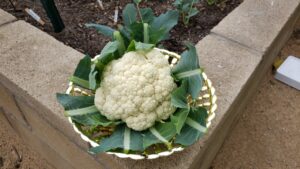
Cauliflower
- Spinach
6 on the list is spinach. Spinach is a great fall plant that acts as a cut-and-come-again plant providing you with a perpetual and stable supply. You want to make sure that your soil has an abundant amount of organic matter and worm castings in order to keep the soil moist and grow the tastiest spinach. Good nitrogen fertilizers, like well-rotted chicken or cow manure, are also necessary to support the greens. If spinach is grown in the hotter months, it will go to bolt very easily and will start producing flowers. Lastly, spinach is full of vitamins and minerals like vitamin E and magnesium that support your immune system.
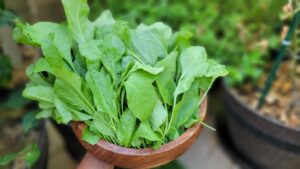
Spinach
- Herbs
Fall herbs are number 5 on the list of veggies to grow. Examples include cilantro and basil. Cilantro produces supple and flavorful leaves when growing in the cooler fall season and it’s best to start cilantro from seeds towards the beginning of the season. Cilantro is typically grown as a cut and come-again plant and you can harvest a lot of cilantro leaves before pulling the entire plant out. We love growing cilantro in our greenstalk herb planter, which is perfect for herbs, to save garden space. Cilantro is one of the herbs that’s best grown and harvested fresh. Home-grown cilantro’s fragrance and taste are much better than the of grocery store cilantro. But while growing it at home, make sure to add organic matter, manure, or any other fertilizer to grow good quality cilantro. Cilantro is a great fall herb because if you grow cilantro in the hotter months, they will bolt meaning you’ll have thin leaves and lots of flowers. Basil is also perfect to grow in the cooler fall weather and there are very interesting basil varieties to choose from, such as the boxwood basil, the classic sweet basil, the Thai basil and the holy basil. Each variety provides its own strengths and uses, usually in cooking.
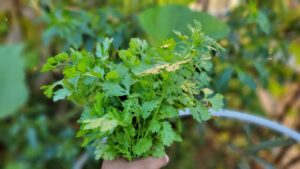
Cilantro
- Peas
Number 4 on the list are peas, one of the most underrated plants to grow that are crunchy, delicious, and very productive in the garden. Shelling type peas and snap peas are both cool-season crops that thrive in the fall. Peas also fix nitrogen in the soil so they don’t need a lot of fertilizer, however amending your soil with organic matter is a must if you want healthy plants. Due to their lightweight vines, peas can be easily grown in containers with a tomato cage or a trellis even. In fact, growing them in a raised bed along a trellis will give them a lot more room to grow and will, in turn, make your harvest much bigger. As the peas mature on the plant they turn from very sweet to less sweet, so if you like sweeter peas, harvest them when they are petite or tender and if you like to cook them, harvest them when they are a bit more mature. Peas are a great source of protein, are high in vitamins C and E, and rich in zinc too. The high concentration of vitamins, minerals, antioxidants, and phytonutrients in peas provides important health benefits that range from keeping your eyes healthy to protecting you against certain cancers.
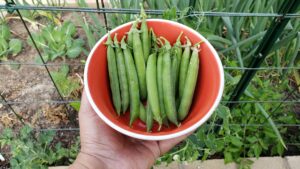
Peas
- Radishes
3 on our list is radishes, which come in a variety of colors like the watermelon radish or the bright red cherry belle radish. During the cooler fall months, the long white variety and the purple or pink daikon radish are the best to grow. You can grow radishes in a variety of ways, we grew purple daikon radishes in shallow containers, cherry belle radishes in greenstalk planters, and the white minowase radishes in raised beds. When growing radishes, be careful not to add too much fertilizer (especially nitrogen fertilizers) because it will produce good leaves but small roots. So ensure that your soil has good organic matter and well-draining soil. Growing and eating radish may be the best decision for your garden and good health Radishes are packed with vitamins E, A, C, B6 and K and they are high in antioxidants as well as fiber, zinc, potassium, phosphorous, magnesium, copper, calcium, iron and manganese.

Radish
- Broccoli
Second, on the list is one of my favorite vegetables to grow and eat, broccoli. Broccoli is best grown in seed starting cells to then be transplanted in fall, where it can grow in the cooler fall and winter weather. Broccoli grown in the hotter months will bolt very soon and produce flowers and while edible, the best way to eat broccoli is by harvesting nice sized green heads which grow in cooler weather. When growing broccoli, make sure to enrich your soil with good quality fertilizers, like a vegetable fertilizer, and lots of organic matter and worm castings so that the plant can uptake all the nutrients it needs. Adding a good supply of a nitrogen-rich fertilizer, like chicken manure, every month following planting will boost the nitrogen content in the soil and produce good-sized broccoli heads. Although broccoli plants produce one main and firm head, they continue to produce through the side shoots making it important to grow early in the fall in order to harness its productivity. It’s also recommended to grow broccoli plants in raised beds as this large vegetable has a deep root system.

- Carrots
Number 1 on the list is carrots! Carrots come in a wonderful array of colors and interesting shapes. They are extremely easy to grow and are typically grown in containers and raised beds. We prefer growing them in whiskey barrel containers as they can accommodate and grow a large number of long carrots. In order to grow carrots, you can sow seeds on the surface of the soil and cover them with straw. If carrot seeds are tough to sow due to their small size, you can also utilize pelleted seeds. While growing your carrots, keep the top portion of the soil moist and in 15 days you will have carrot seedlings growing. Within 90 days, you can start harvesting your carrots! Carrots are a delicious delight to grow and can last a very long time in the refrigerator. These vegetables are rich in antioxidants, beta-carotene, potassium, and fiber. Carrots benefit eye health and gut health, and boost the immune system and heart health.
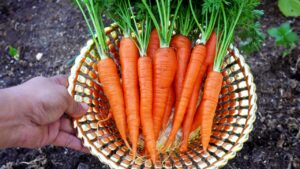
Carrot
Watch our episode Top 10 Vegetables to Grow in Fall & through Winter
on California Gardening.
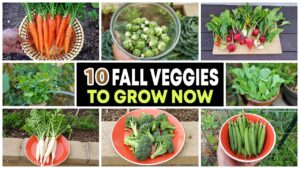
YouTube Logo

0 Comments